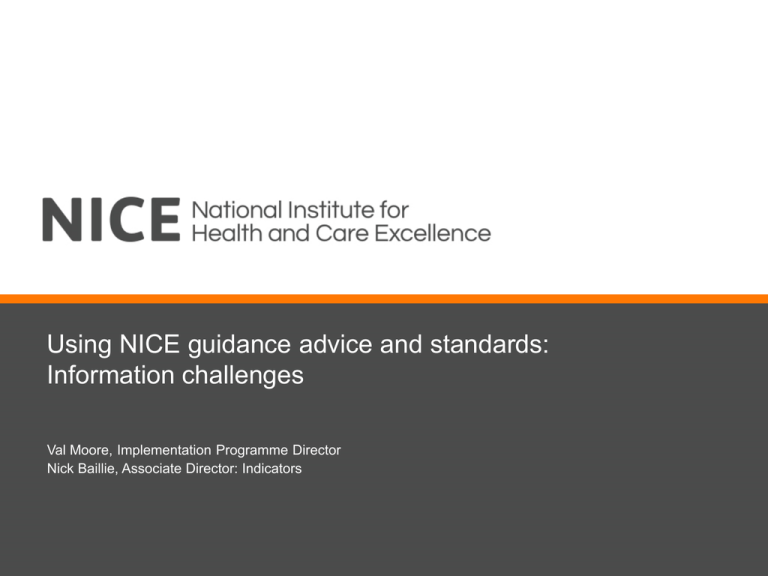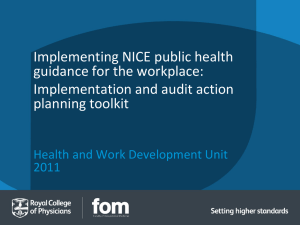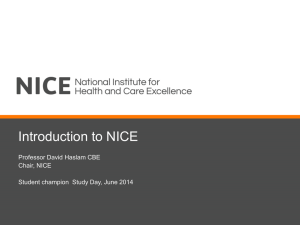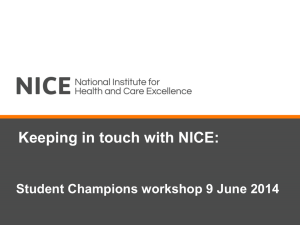NICE - HC2013
advertisement

Using NICE guidance advice and standards: Information challenges Val Moore, Implementation Programme Director Nick Baillie, Associate Director: Indicators The role of information in implementation • Context Understanding role of information in implementation – Stimulate change – Evaluating change – Sustaining change Technological progress Demand for accountability • Today - Using information in implementation: – Technologies – Clinical guidelines and other NICE guidance – Standards & indicators Board reports on uptake information Medicines and technologies focus Date Types of NICE guidance Evaluation method 2000 NICE technology appraisals (TA’s) – cost utility evaluation method, mostly of medicines Cost utility 2010 Diagnostic evaluations Cost utility 2010 Medical device evaluations – cost benefit Cost benefit 2012 New medicines information and evidence summaries review 2013 Highly specialised medicines Process tbc Medicines and technologies focus Date Types of NICE guidance Cost, volume, 2000 NICE technology appraisals (TA’s) – cost utility recommended evaluation population, other method, mostly of medicines options, variation and variation over time Evaluation method 2010 Diagnostic evaluations Cost utility 2010 Medical device evaluations – cost benefit Cost benefit 2012 New medicines information and evidence summaries review 2013 Highly specialised medicines Process tbc Cost utility Experimental statistics on variation • Section 1 - observed and expected use data from 13 of 25 treatment groups suitable for analysis •Section 2 - further groups where a valid interpretation couldn’t be made Innovation, Health & Wealth NICE compliance regime Innovation scorecard NICE Implementation Collaborative Formularies • Scorecard to provide a high level view of an NHS organisation’s use of technology appraisals (medicines and technologies) at Trust and CCG level data • Medicines featured within the annual Use of NICE appraised medicines report are a source • First one published in January 2013 • FAQ’s …. Innovation, Health & Wealth NICE compliance regime (2) Innovation scorecard NICE Implementation NIC Collaborative Formularies • NICE Implementation Collaborative aims to: – support and promote the timely and consistent implementation NICE TAs and adoption of all other forms of NICE guidance – drive the uptake of innovation, understand the barriers and help overcome them – oversee 4 pilots (newer anticoagulants, denusomab, BNP testing, insulin pumps) – report on the assessment of the implementation issues, and action at national level to improve uptake. Opportunity of Academic Health Science Centres to inform and act. Other types of guidance Date Types of NICE guidance Evaluation method 2002 Clinical guidelines Cost utility 2005 Public health interventions and programme guidance Cost utility 2013 Service guidance Process tbc 2003 Interventional procedures Safety and efficacy – no cost effectiveness assessment Other types of guidance Date Types of NICE guidance Evaluation method 2002 Clinical guidelines Cost utility Local JSNA, 2005 Publicpolicies health,interventions and programme audit, national guidance measurement: obesity, physical 2013 Service guidance activity, 2003 Interventional procedures Cost utility Process tbc Just safety and Clinical coding, efficacy (no cost registries, audit foreffectiveness assessment) consent and outcomes Using NICE audit tools to improve patient care • ‘Thinking delirium’ in Herts and Beds critical care units • An audit based on the NICE clinical audit tool for the Delirium guidance • Baseline audit in June 2012: Standard Result If indicators of delirium are identified, an assessment based on CAM ICU has been carried out in the previous 24 hours. 71% If a positive score is recorded, action is taken. 50% • • • • Action plans included: – the use of NICE implementation tools – local education – consultant champions – assessment score in nursing team handover sheets – hosting a regional delirium conference. Re-audit in January 2013: Standard used 2012 2013 If indicators of delirium are identified, an assessment based on CAM ICU has been carried out in the last 24 hours. 71% 80% If a positive score is recorded, action is taken. 50% 72% Further improvement work and audit is planned. For further details see www.nice.org.uk/sharedlearning Guidance and quality standards A comprehensive set of recommendations for a particular condition or service area Evidence Guidance Quality Standards ‘Sentinel markers’ A prioritised set of concise, measureable statements designed to drive quality improvements across a pathway of care. NICE quality standards • NICE quality standards are a concise set of statements designed to drive and measure priority quality improvements within a particular area of care • Library of 180 topics across clinical, public health and social care • Each statement has associated measures • National data collections and local measures What are NICE quality standards? They do not restate essential standards or regulatory requirements. Where there is overlap, statements should be mutually supportive and complementary. NICE quality standards Registration requirements Proportion of services Standard of services Unsafe Substandard Adequate Good Excellent Quality standards referrals • Library of 180 quality standards (QS) – including 3 public health focused topics • Smoking Cessation (Nov 12) • Physical Activity (Oct 13) • Alcohol (Dec 13) Social care • Pilot programme – social care QS – Supporting people to live well with dementia – Health & wellbeing of LACYP – Full programme went live in April 2013 • Mental wellbeing of older people in care homes (Feb 13) • Autism (Mar 13) NHS Public health How can quality standards be used? NICE quality standards help demonstrate delivery of high quality care through measureable statements and indicators, to be used in a variety of ways in England including: National • NHS Outcomes Framework domains • Quality & Outcomes Framework (QOF) and Clinical Commissioning Outcome Indicator Set (CCG OIS) • National audit and data collection • Commissioning for Quality Improvement Initiatives (CQUIN) Local • Local audits and local contracts NICE Quality Statement 1: People with diabetes and/or their carers receive a structured educational programme that fulfils the nationally agreed criteria from the time of diagnosis, with annual review and access to ongoing education • 74% of PCTs have contracts with services to provide NICE compliant education for people with newly diagnosed Type 1 diabetes and 85% have contracts to provide NICE compliant education for people with newly diagnosed Type 2 diabetes, but only 66% review whether all people newly diagnosed are offered structured education. • For patients under their care, two-thirds (66%) of specialist providers offer NICE compliant structured education to all people newly diagnosed with Type 1 diabetes and 84% offer ongoing education. In addition, 70% provide structured education for people using insulin pump therapy. • 72% of paediatric specialist teams offer structured education to all newly diagnosed children and young people and 75% adjust the education to the development stage of the child/young person. However, only 52% have a written schedule of education from diagnosis onwards, with 59% monitoring uptake of education. Source – DiabetesE www.innove.co.uk Information challenges • How can we ensure quality measures are adopted within national collections? • How can we minimise the burden of data collection where no national measures? • Additional challenges within the quality standard development process Indicators • NICE develops evidence based indicators from quality standards, NICE guidance and accredited guidance • Rigorous development methods including testing, public consultation and consideration by committee Quality and Outcomes Framework (QOF) • Introduced in 2004, the QOF is an incentive scheme for GP practices in the UK, rewarding them for how well they care for patients • The QOF contains groups of indicators, against which practices score points according to their level of achievement • The QOF gives an indication of the overall achievement of a practice through a points system • NICE publish a menu and final indicators negotiated by BMA and DH (NHS England in future) Clinical Commissioning Group Outcomes Indicator Set (CCG OIS) • Supports CCGs and health and wellbeing partners in improving health outcomes by: – providing comparative information on the quality of health services commissioned by CCGs and the associated health outcomes – supporting transparency and accountability by making this information available to patients and the public • Includes some proxy indicators of outcomes that are good predictors of improvement: – ‘intermediate’ outcome indicators – processes that are shown to have a strong link to outcomes • range of areas, for which they score points. Clinical Commissioning Group Outcomes Indicator Set (CCG OIS) • August 2012: NICE menu of indicators published • August 2012– September 2012: NHS Commissioning Board (NHS England) engagement events • December 2012: NHS Commissioning Board (NHS England) published first CCG OIS Information challenges • QOF is an example of how improvements in informatics can be driven by quality agenda • CCG OIS: how can we ensuring data is available to ensure indicators can be constructed by commissioning group? Future uptake sources Outcomes frameworks • QOF • CCG OIS • NASCIS • HQIP Social Care national audit Innovation, Health and Wealth • NICE Implementation Collaborative • Innovation scorecard New data sets • Cancer Outcomes and Services Dataset • General Practice Extraction Service Other • Commissioning for quality and innovation (CQUIN) payment framework • Quality, Innovation, Productivity and Prevention (QIPP) comparators Summary • NICE guidance at the heart of many improvement activities • Information is vital to stimulate, evaluate and sustain change • Challenges in data collection, attribution and reporting • Examples exist of the use of indicators and routine data for quality improvement






